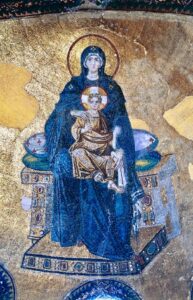God with us

Behold, a virgin shall be with child, and shall bring forth a son,
and they shall call his name Emmanuel,
which being interpreted is, God with us. Matthew 1:23
Every year, in churches across the world, Christian priests and pastors give sermons about the “true meaning of Christmas.” Love will be mentioned, the act of giving will figure prominently, the familiar story of the Nativity told in all its beautiful simplicity…
We’ve heard it all before, which means that, all too often, we do not hear it at all.
It is certainly true that the themes of love, giving, the relational bonds of friends and family are central to our understanding of Christmas; but what is less clear to us is that, at the most fundamental level, the true meaning of Christmas is the fact that it actually has interior meaning. Something deep and integral is written into it.
God is a poet, a creative consciousness at work on the largest of scales. The universe and the unfolding of humanity’s story within it is a poetic saga involving a layering of symbol, image and metaphor written across and beyond time. Reading it is our imperative. Seeking to understand it is the task for which we were designed.
How, then, are we meant to “read” the Nativity?
The medieval era was much better at interpreting the symbolic language of the Christian story than modernity. There is a lovely fourteenth century Christmas song (part of John of Grimestone’s Preaching-Book) which captures the deeper vision lost to us. The song is a lullaby written to the Christ Child. In it the poet (speaking perhaps in the role of the Virgin Mary) grieves for the pain and suffering the innocent child is born to bear:
Poure and litel art thou made, uncouth and unknowe,
Pyne and wo to suffren heer for thyng that nas thyn owe.
Poor and little art thou made, unheralded and unknown,
Pain and woe to suffer here for something not thine own
I was put in mind of the medieval lullaby this week when I read the next poem in Sophia’s Loose Leaves (from which I have been reading a poem each week at her graveside). Sophia’s poem is a reflection on the Pietà, a depiction of Mary holding her dead son, the crucified Christ. Sophia, as did the medieval poet, drew a direct line between the Nativity and the Crucifixion, because, to the mind reading the poetry of God, they are inextricably linked.
And though he lies on her lap
Limp as a sleeping infant
He is bound not in swaddling clothes but in death
At the heart of both the Nativity and the Crucifixion lies the mystery of the Incarnation, the astonishing concept that the Divine Consciousness entered into the world, became literally embodied—not, as in the Graeco-Roman pantheon, as a simulacrum of humankind (like Athena appearing in disguise in The Iliad), but as a full participant in human life with all its joys and (as both the medieval poet and Sophia remind us) all its sorrows.
The medieval poem ends with a resonant if poignant couplet:
Lullay, lullay, litel child, softe sleep and faste,
In sorwe endeth every love but thine atte laste.
All love in this world of ours ends in sorrow. Here lies the terrible human truth which those who deeply mourn know: love has loss written into the heart of it.
Yet…
A promise has been made to us, a gift—a Christmas gift—has been given to us. The love of God for humankind, embodied in the form of the little child born to Mary two thousand years ago, this love defeats death, this love will end all sorwe atte laste.
This is a gift indeed.
Blessings to all at Christmastide,
R

Beautiful writing Robyn. As I logged into my bible app today this was the first “daily verse” that popped up, and I think it’s really fitting here.
‘Do not deceive yourselves by just listening to His word; instead, put it into practice. Whoever lists to the word but does not put it into practice is like a man who looks in a mirror and sees himself as
he is.’ James 1:22-24
Yet, I actually came to post another verse after contemplating your writing:
‘Love is as powerful as death; passion is as strong as death itself. It bursts into flame and burns like a raging fire. Water cannot put it out: no flood can drown it. But if anyone tried to buy love with
wealth, contempt is all they would get.’ Song of Songs 8:6
You are so right, Ben. Love is eternal
It shines out into the world–never to be lost, never to be extinguished.
This inner light threads the universe together and us with it…how beautiful that thought is!
Thank you Robyn. Your writing is always beautiful. Yes, the incarnation is coupled with the crucifixion, but that is inextricably coupled with the resurrection and new life.
Truly. As the medieval poet says, all love within the world ends in sorrow–it is only Christ’s love which is able to transcend it.
In that love and through that love alone all sorrow ends…because death is, through the Resurrection, defeated by it.
She fell like leaves from a book that could not hold her.
As Sophie says in her Apotheosis as an Eagle poem, dear G, it really was “A fall into grace.”
Love to you, dear friend.
R